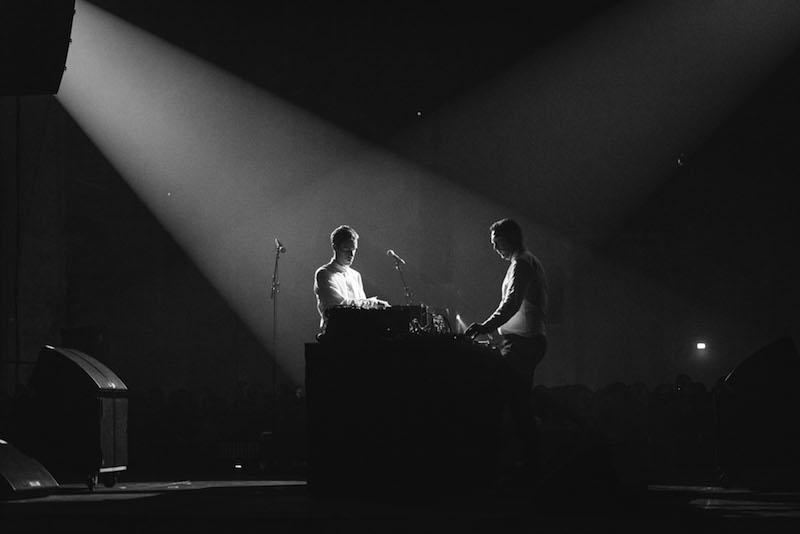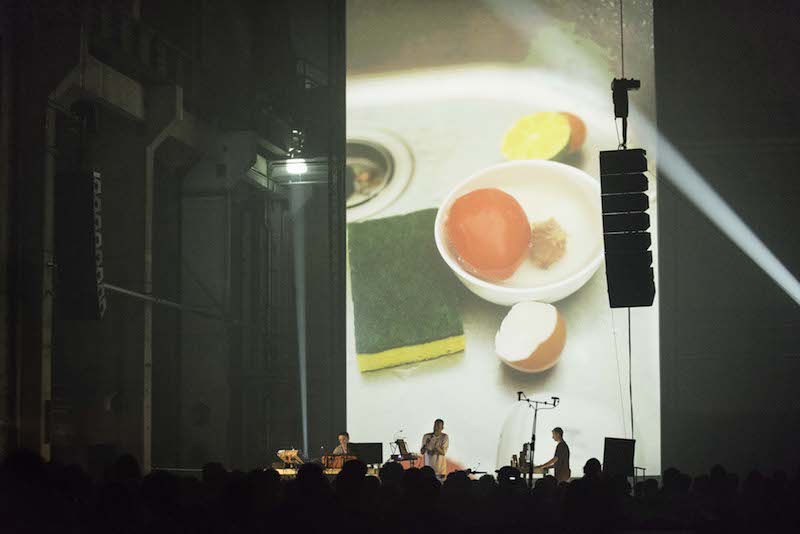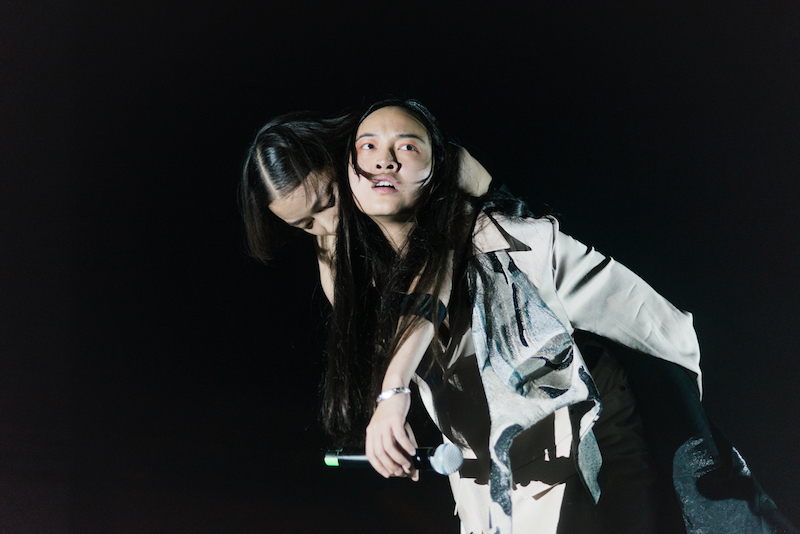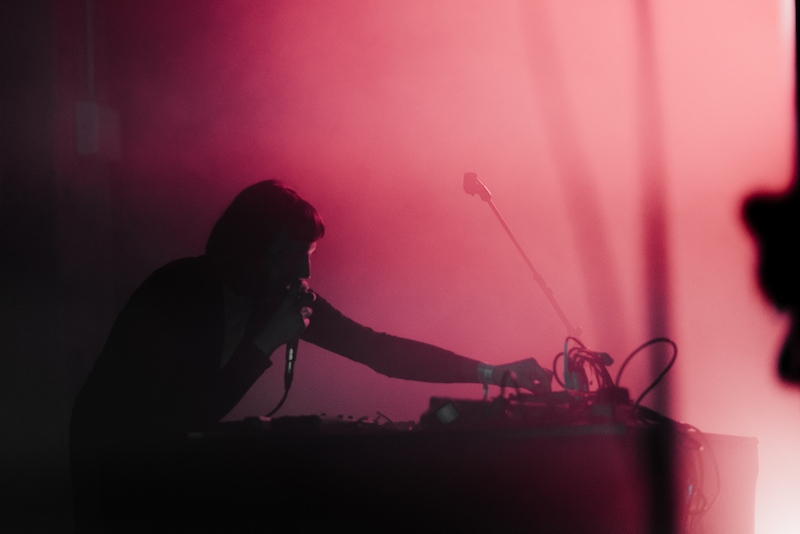This month the German capital’s renowned experimental electronic music festival, Berlin Atonal, returned to its permanent home at Kraftwerk in Kreuzberg. The festival’s extended duration, both in terms of its individual sound works and its span of five days, was enough to install a level of fatigue and delirium familiar to Berlin’s techno community. Yet at Atonal, the insularity often exhibited by weary clubbers appeared supplanted by an engaged audience; there was an omnipresence of genuine interest in the performers’ skilful operation of hardware, but even more so the performativity of the selected acts, many of whom are known for their vigorous stage presence. Although the copious technical equipment was always going to be the predominant focal point for electronic music fans, it was the theatricality of the performances within the monumental Kraftwerk building that made it such an exhilarating endeavour.

Damien Dubrovnik, Berlin Atonal 2017 // © Camille Blake
Known for fostering newfound creative collaborations, Atonal served up a rich selection of inter-disciplinary undertakings. The most outstanding acts were those premised on effective synchronization of sight and sound, while maintaining enough disjuncture to keep it stimulating. Electronic producer Powell’s seamless production of breakbeat techno with interludes of post-punk vocals coincided with a schizophrenic visual selection of artist Wolfgang Tillmans’ short films. Similarly, in the performance of dark ambience produced by Demdike Stare, no one seemed able to look anywhere but the front; the towering screen behind them provided a selection of video works by filmmaker and animator Micheal England, which moved from representing performances of surreal interpretive dance into a pouting unit of drag queens. With its slow-burning crescendo and the pronounced movements of the duo, the live performance from Roll the Dice seemed closer to an orchestral score than a techno set.

Powell and Wolfgang Tillmans, Berlin Atonal 2017 // © Camille Blake
Even when overriding control was surrendered, the seemingly improvisational live performances seemed far from sporadic. Harnessing together years of field recordings, Spanish electronic DJ and producer JASSS transported us to a dystopian realm with her signature jarring drone sounds, which washed over us with stretched moments of pulsating thuds. Premiering their new project ‘ALTAR,’ Roly Porter and Paul Jebanasam delivered a sprawling soundscape of rattles and thuds. All around the atmosphere was heavy with energy and intensity, not least thanks to the force of the immense speaker system propelling in quakes throughout Kraftwerk’s concrete buttressing. With so many strange, otherworldly sounds ricocheting about, the limits of everyone’s endurance were consistently pushed. Being lulled into a passive trance seemed impossible; many of the performances kept you ever-alert and, once they finished, left you wondering what you were just put through. The screeching outbursts and operatic flow contained in Pan Daijing’s premiere performance of ‘Fist Piece,’ were nothing like a light-hearted immersion, but ignited a corporeal reaction that could only be described as existential hyper-awareness.

Pan Daijing, ‘Fist Piece,’ Berlin Atonal, 2017 // © Helge Mundt
Indulging in full-scale melancholy was not even an option for many of these performances, as electronic professionals consistently propelled us through unexpected riffs and turns in their sets. In the performance by Danish duo Damien Dubrovnik, vocals were so heavily abstracted they seemed to merge with the synths. Occasionally during their performance, the turmoil slowed down to allow us to contemplate the haze of a moody drone. Damien Dubrovnik is focused on connecting with their audience, and watching Loke Rahbek repeatedly hurtling towards the microphone to dispense more severe vocals shaped the whole experience into a kind of cathartic feedback loop. The dedication to performing was a marked feature of several other acts, sometimes aptly achieved without such vigorous physicality. As part of a live audio-visual collaboration between Shackleton, Strawalde and Pedro entitled ‘Behind the Glass,’ Anika delivered an almost deadpan narration of a surreal fable about love through dominance and submission. Far from being a tiresome tirade, her deliverance bore the weight of a harrowing sermon.
Frequently at large-scale festivals oriented towards music, commissioned artworks can become lost within the assorted stimuli in circulation. This was less the case at Atonal, where all the work on display seemed to both merge seamlessly within its surroundings and demand attention to their individual presence. ‘GRAVITY,’ composed of tensed wires hung from Kraftwerk’s 20 metre-high crane, repeatedly flung spinning light entities upwards before gravitational pull dragged them struggling back down. Although this work integrated within the space effectively, the work was not well-lit enough, so its impact was partially lost. Moving further in, I encountered the bulbous form of David Spriggs’ ‘Divided Power,’ an installation of layered sheets of transparent film, painted with acrylic and lit from above. The suspension of this work over the staircase leading to the basement allowed for its observation from various vantage points. It even became an introductory adornment for the entrance to another piece: ‘Phyllotaxis’ by Joris Strijbos and Daan Johan. Placed within Kraftwerk’s basement, this piece involved three spinning kinetic machines that omitted vibrating light particles, self-controlled by modular synthesizers. A thrilling experience that quickly became an assault on the eyes; solace could be found in the panoramic film screening on an upstairs level.

JASSS, Berlin Atonal // © Helge Mundt
As would be expected from both established and rising experimental pioneers, this year’s Atonal demonstrated both masterful control of the technical equipment and the virtues of allowing machines to dictate performative outcomes. With such a diverse selection of sonic output over the extended period, it is difficult to consider five days of experiments as a totality. On a technical level, the festival triumphed; the sound was never lost in a spiralling reverb in Kraftwerk’s colossal rafters, but loomed low in an impenetrable mass upon those of us standing below. But it was in terms of phenomenological sensation that the events left their mark, in the way that sight, sound and visuals merged to provide a lively space for exploring the work of emerging and established professionals.





















